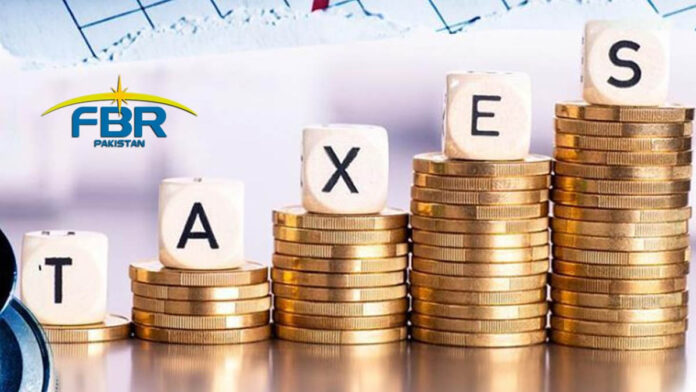ISLAMABAD: The upcoming federal budget would entail an increase in federal tax revenue by about Rs1.155 trillion, including Rs430 billion worth of additional tax measures, according to the International Monetary Fund (IMF).
On the other hand, the government would target a much lower recovery on account of petroleum levy than the budgeted Rs610bn for the current fiscal year (FY2021-22) because of significant slippages in government’s efforts to partially contain the rising prices of petroleum products.
This is part of the IMF’s mandatory article-IV consultations along with sixth review of its Extended Fund Facility (EFF) under which Pakistan has missed or completed with significant delays a series of targets under structural benchmarks, indicative targets and performance criteria.
As per the IMF report, the Federal Board of Revenue (FBR) is required to collect Rs7.255tr during the fiscal year 2022-23, compared to the revised target of Rs6.1tr for current financial year, showing an increase of Rs1.155tr. The expansion of about Rs730bn is expected on account of four per cent growth in GDP, coupled with about 8pc inflation. The remaining Rs430bn or so would have to be generated through taxation measures, including personal income tax — higher tax rates and lower tax exemption limit.
The FBR’s tax-to-revenue would thus increase to 11.8pc next year against 11.2pc estimated during the current year. Of this, about 0.4pc of GDP would come from federal excise and 0.2pc from general sales tax.
A major increase of Rs520bn in FBR revenue is anticipated to come from general sales tax for which Rs3.3tr would be set in the upcoming budget compared to Rs2.78tr this year. The IMF and Pakistani authorities have revised the target for petroleum levy from Rs607bn during the current year to Rs356bn as its rate was kept on the lower side during the first half of the fiscal year. In view of the rising international oil prices, the next year’s target for petroleum levy is being kept at Rs406bn.
Likewise, the non-tax revenue target for the next fiscal year would be kept at Rs1.58tr, up about Rs200bn against the current year’s revised target of Rs1.38tr. The debt servicing is also projected to go up by about Rs453bn to Rs3.523tr next year, up almost 1pc of GDP over the current year’s interest payments of Rs3.07tr.
The defence expenditure is projected to go up by Rs186bn to Rs1.586tr from Rs1.4tr this year. As percentage of GDP, interest payments would remain unchanged at 5.7pc.
Ironically though, the overall Public Sector Development Programme (PSDP) would be curtailed by about Rs60bn next year to Rs1.81tr compared to the revised estimate of Rs1.87tr for the current year. While the federal PSDP would remain almost unchanged at Rs555bn, the provincial development programme could come down by Rs60bn to Rs1.251tr from Rs1.317tr this year.
This means the development budget next year would be significantly lower in real terms when seen in the context of inflation. This is also evident from the fact that the total development outlay would come down to 2.9pc of GDP next year from 3.4pc this year. The federal PSDP-to-GDP ratio would decline by 0.1pc to 0.9pc, while the provincial development programme would come down to 2pc of GDP next year against 2.4pc this year.
In its evaluation, the IMF noted that the overall programme performance had been uneven and “several quantitative criteria were missed and gaps in implementing particularly the fiscal and structural reform agenda arose amid challenging circumstances, including the Covid-19 pandemic and spillovers from Afghanistan, but also a waning decisiveness to push forward agreed reforms”.
The Fund said the economy was set to continue recovering to reach 4pc this year but risks remained high in FY2022. Assuming sustained policy and reform implementation, growth is expected to reach its medium-term potential of 5pc.
“Average CPI inflation is expected to temporarily increase in the coming months and average 9.4pc in FY2022 due to the recent terms of trade shock, continued energy price adjustments, and GST reforms. It is expected to be within the SBP’s 9-11pc inflation range forecast in the next 12 months, before slowing to 6.5pc over the medium term,” it added.
Current account deficit is forecast to widen to 4pc of GDP in FY2022, driven by strong import growth, fueled by strong domestic demand, higher commodity prices, and slightly receding remittances. Downside risks to the outlook and programme continue to dominate.
The authorities and staff agreed that these fall under five broad groups. First, with still low vaccination coverage, Pakistan remains vulnerable to a worsening of the pandemic trajectory. The authorities expect outbreaks to have smaller domestic economic impact than before but remain concerned about high global uncertainty that could affect global growth, trade and remittances.
Second, policy slippages remain a risk, as has also become more visible in recent months, amplified by weak capacity and powerful vested interests. Socio-political pressures could also weigh on policy and reform implementation, especially with the next general elections expected in mid-2023.
Third, further delays in structural reforms, especially those related to governance and the authorities’ anti-money laundering/combating the financing of terrorism (AML/CFT) action plan with the Financial Action Task Force, could hamper external financing and investment and thus limit the economic recovery.
Fourth, geopolitical tensions (especially related to Afghanistan) could cause disorderly migration, worsen security conditions and generate higher volatility in basic food prices (if supply is disrupted) and the exchange rate. Apart from direct spillovers to Pakistan, the tensions could cause an adverse shift in investor sentiment and affect external financing.
Finally, climate change risks are mounting, including a tendency for more frequent climate-related disasters.

